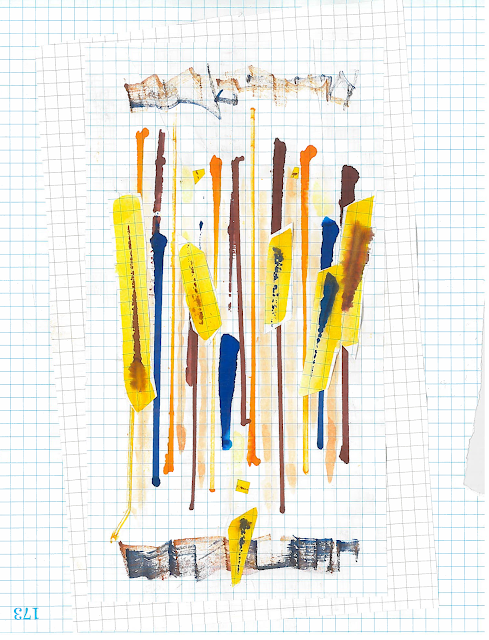TO TELL OF BODIES CHANGED
Jana Prikryl
Having desired little
more than the
arrival of the little more
that arrives,
outside our window a cypress
of model proportions.
Its patience seems to widen
the nights we sleep in Rome.
Warm flags draw a tortoise,
it scrapes too near.
Our friends hurry over when they hear,
exclaiming over its mute
resolute
distinctness and helpless slow efforts to flee.
Density pours into swallows and shadows:
spilled with abandon each morning,
begins then the slow work
of receding.
The joints announce their new allegiances.
Metaphors swarm the surfaces of things.
Night broken into, it's the sub rosa
singling out
I ought to have expected
from Fra Angelico's small panel
among others,
the souped-up full-spectrum wings
combined with a mood of reverent submission
in both figures
warning of experience
yet to come.
Starting now she'll reason with herself
deliberately
(imagine bulbs expecting stars
for effort!), aware of being always overheard,
subject to unprecedented measures
of integrity, like an author.
While a substance of landscape, mineral,
leaches into blood vessels
quietly steadily, meaning in this case
nothing is damaged;
extravagance of umbrella pines
propping their fingers under the bonus horizons
of the hills, redundancies
boosting the city's resemblance to itself.
A painter once squared himself against a difficult question
and said no one could just create
a landscape,
but isn't it true
that expectation builds a neighborhood
and there is nowhere else that you can live.
It was possession, turns out, by a force whose intention
touched the first body alone, a body changed
again precisely to its own form,
a very special intention.
Alloyed
discretion, the grit of a damp trowel
explores my mouth, at leisure
determining
the candor that cavity
is good for.

i too was favourably impressed by the blog you link to first in today's post - last positivist's the sooty empiric - in fact he had me at the dialect caption to tullio crali's futurist painting -
ReplyDeleteand i was reminded of the following poem
Mia Carlotta
GIUSEPPE, da barber, ees greata for "mash,"
He gotta da bigga, da blacka mustache,
Good clo'es an' good styla an' playnta good cash.
W'enevra Giuseppe ees walk on da street,
Da peopla dey talka, "how nobby! how neat!
How softa da handa, how smalla da feet."
He raisa hees hat an' he shaka hees curls,
An' smila weeth teetha so shiny like pearls;
O! many da heart of da seelly young girls
He gotta.
Yes, playnta he gotta—
But notta
Carlotta!
Giuseppe, da barber, he maka da eye,
An' lika da steam engine puffa an' sigh,
For catcha Carlotta w'en she ees go by.
Carlotta she walka weeth nose in da air,
An' look through Giuseppe weeth far-away stare,
As eef she no see dere ees som'body dere.
Giuseppe, da barber, he gotta da cash,
He gotta da clo'es an' da bigga mustache,
He gotta da seely young girls for da "mash,"
But notta—
You bat my life, notta—
Carlotta.
I gotta!
T.A. Daly, 1909
_______________________________________
about the author - Rebecca Oviedo, Distinctive Collections Librarian/Archivist (exhibit curator), Villanova University, writes, in April 2021
Philadelphia’s own “Tom” Daly
You may not have heard of Thomas Augustine Daly – a native and lifelong Philadelphian; an Irish-American and a Catholic; a journalist, poet, and prolific author; and an early Villanova alumnus. Daly was best known for his humorous verse written primarily in Italian-American or Irish-American dialect. When we read these depictions of speech today, our initial reaction is likely one of cringe-inducing disgust or dismissal. Yet in his day he was a “universally loved figure in American literature” and perhaps as one reviewer claimed, “the most widely quoted in this country.” While other authors who wrote in dialect – so fashionable at the turn of the twentieth century - such as Joel Chandler Harris and Mark Twain, or James Whitcomb Riley and Paul Laurence Dunbar (to whom Daly has been compared), have endured, waned, or been re-evaluated, Daly seems to have fallen out of favor or been entirely forgotten.
This exhibition brings together newly digitized materials from Villanova University’s Distinctive Collections along with a majority of Daly’s published corpus. Daly’s notebooks, scrapbook, and published prose give us glimpses into his own life deeply rooted in Philadelphia's Irish and Catholic communities, while his poetry is strongly themed around a broader American identity through the everyday characters he created. His contemporary critics widely viewed his portrayals of immigrant characters as distinguished by sympathy and understanding rather than as harmful or offensive.
However, some of the works in this exhibition do include language that is discriminatory and offensive. Yet rather than censoring American history, there is value in addressing such texts for how they can provide understanding about why, how, and by whom racial and ethnic slurs were used historically to refer to particular groups of people. These materials can be used by students, faculty, and researchers to think critically and open discourse on topics such as racism, stereotypes and bias, the immigrant experience (historically, as well as today), cultural appropriation and authenticity, and to promote cultural awareness and sensitivity.
"mash" in the sense it is used in daly's poem - see http://word-detective.com/2011/03/mash-note/
DeleteOn the blog page, yes. It used to show little works symbols that I could click on to edit. I can still do it by going to the dashboard, or whatever it is, and selecting "layout".
ReplyDelete